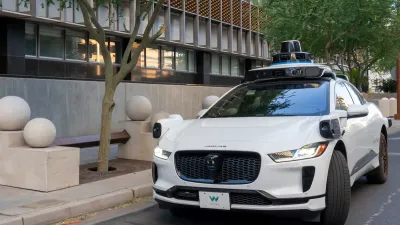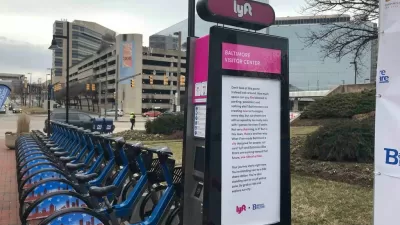You remember the one showing the amount of space occupied by 60 people on a bike, 60 people on a bus, and 60 people in cars? It's also helpful for making a convenient point about Uber and self-driving cars.

Jon Orcutt, communications and advocacy director for Transit center, turned a familiar image on its head this week, posting the following tweet:
— Jon Orcutt (@jonorcutt) June 29, 2016
You'll remember the original image, which Jon Orcutt references with apologies, from Twitter, Facebook, and, yes, Planetizen.
With apologies to the original pic.twitter.com/Wlb3b5IP5k
— Jon Orcutt (@jonorcutt) June 29, 2016
The point is fairly simple: a car is a car, and with the car comes inefficiencies with only theoretical potential for improvements. Ron Kilcoyne made a related point in November 2015 about the potential for autonomous vehicles to explode vehicles miles traveled, and the negative externalities that would come along with that "disruption"—even if congestion isn't one of them.
Regarding transportation network companies, the jury is still out on the effect on congestion of Uber and its brethren, and early efforts to connect TNCs with transit, or paratransit, have yet to prove effective in reducing congestion or pollution.
FULL STORY: Space required to transport 60 people

Alabama: Trump Terminates Settlements for Black Communities Harmed By Raw Sewage
Trump deemed the landmark civil rights agreement “illegal DEI and environmental justice policy.”

Planetizen Federal Action Tracker
A weekly monitor of how Trump’s orders and actions are impacting planners and planning in America.

Why Should We Subsidize Public Transportation?
Many public transit agencies face financial stress due to rising costs, declining fare revenue, and declining subsidies. Transit advocates must provide a strong business case for increasing public transit funding.

Judge Orders Release of Frozen IRA, IIJA Funding
The decision is a victory for environmental groups who charged that freezing funds for critical infrastructure and disaster response programs caused “real and irreparable harm” to communities.

‘Clybourne Park’ Sets Stage for Housing Equity Discussions
Clybourne Park, a play exploring race, real estate, and community tensions, can set the stage for discussion on the lasting impacts of housing discrimination, gentrification, and the fight for affordability.

Understanding Road Diets
An explainer from Momentum highlights the advantages of reducing vehicle lanes in favor of more bike, transit, and pedestrian infrastructure.
Urban Design for Planners 1: Software Tools
This six-course series explores essential urban design concepts using open source software and equips planners with the tools they need to participate fully in the urban design process.
Planning for Universal Design
Learn the tools for implementing Universal Design in planning regulations.
Caltrans
Smith Gee Studio
Institute for Housing and Urban Development Studies (IHS)
City of Grandview
Harvard GSD Executive Education
Toledo-Lucas County Plan Commissions
Salt Lake City
NYU Wagner Graduate School of Public Service





























